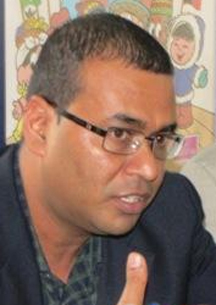The Guyana Government is working on several options for the mining industry in face of the impending ban on the trade in mercury, according to Natural Resources Minister, Robert Persaud.
Efforts, he reported to the National Assembly, are being made to lobby the international community to create a mechanism for developing countries to assist in “technological advancement” to benefit small and medium scale gold and diamond miners.
The gold mining industry here uses mercury extensively to purify gold but a ban on the trading of the chemical which can harm the environment, is scheduled to take effect next year. Alternatives to the use of mercury are being examined though they have not yet taken hold widely in the sector.

In a written response on Wednesday to a question from APNU’s Dr Rupert Roopnaraine in the National Assembly asking what transition programme is being put in place to mitigate impacts on the small scale and medium scale miners who have traditionally utilized mercury as their sole processing option, Persaud said that the Guyana Geology and Mines Commission is implementing programmes which are geared toward promoting alternative technologies to mercury and promoting improved mineral recovery. He said that it is intended that the activities will highlight the current health risks of using mercury and reiterate the urgent need for a change to mercury-free technologies for the processing of gold.
According to Persaud, field trials and demonstration projects are being carried out to exhibit the use of shaking tables, mini-inline leach reactors, ICOM concentrators and Knelson concentrators which are being tested in the six mining districts of Guyana. He said that preliminary results have shown that the equipment is capable of producing a very clean gold concentrate from gold-bearing black sand concentrates. These technologies can be used to improve the recovery of both free gold and sulphide related gold and in all tests carried out to date, significant increases in total recoveries have been achieved, Persaud said.
Further, the minister said that the ministry is also making efforts to implement a “well-targeted” awareness programme, exchange visits to countries where mercury uses are outlawed, the establishment of a good monitoring programme and the empowerment of strong enforcement institutions. “Efforts are also being made to lobby the international community for the creation of an international mechanism for developing countries and countries with economies in transition for technological advancement. The ministry intends for such assistance to benefit small and medium scale gold and diamond miners so that a safe and effective transition from mercury use can be achieved,” he said.
Persaud noted that environmental and health risk assessments are an integral part of the current field tests and will form part of the feasibility analysis of alternative technologies to mercury amalgamation. He pointed out that the technologies being tested were adopted by other countries and jurisdictions and assessments showed that with proper training and maximum use, these technologies are able to provide the level of sustainability that is required in the mining sector.
Roopnaraine also questioned why the Environmental Protection Agency (EPA) takes more than six months to provide responses for Environmental and Social Impact Assessments (ESIA) when the public only has 60 days from the publication of notices confirming the submission of the ESIA to submit comments to the EPA and Persaud said that the Environmental Protection Act of 1996 does not provide clear guidance on the stipulated time period for the agency to make a decision on whether to approve or reject the EIA. However, he added that the EPA was tasked by the ministry to conduct a review of the timelines associated with the EIA process specifically relating to the response provided to developers after the 60-day period “and it was found that the responses to developers, after the submission of the EAB’s recommendations, is an average of 15 days during the last five years.”
Additionally, in responding to a question on why the Environmental Assessment Board does not adhere to the rules and procedures as outlined in the document titled Environmental Impact Assessment Rules and Procedures, Persaud said that the EAB adheres to the rules and procedures of the document, Environmental Impact Assessment Guidelines Volume 1.
The minister said that the EAB has recognized some areas in the Guidelines which need revision and that the current Board has held meetings with the Environmental Management Division and the Executive Director of the EPA to address areas of improvement and this work is ongoing. For 2012, the Board comprises chairperson Vanessa Benn, Denise Simmons, Omkar Lochan, Nicholas Chuck-a-Sang and Dr. Ashok Sookdeo.
Meanwhile, in relation to a question on the bauxite company Bosai, the minister said that the EPA does not conduct environmental and health risks assessments nor has any independent studies been done to assess the environmental and health risks associated with the emissions from Bosai.
Persaud said that Bosai is the holder of an environmental permit for its bauxite processing operations at Linden that remains valid until November 2014. He said that in keeping with the EPA’s procedures, the company was required to complete an Environmental Management Plan which addresses possible environmental risks associated with its overall operations. Persaud said that the EPA conducts compliance audits of the operations against its Permit Conditions while the company is also required to submit monthly reports. “These monthly reports capture some amount of environmental monitoring including surface and ground water, noise and weather,” he said.





